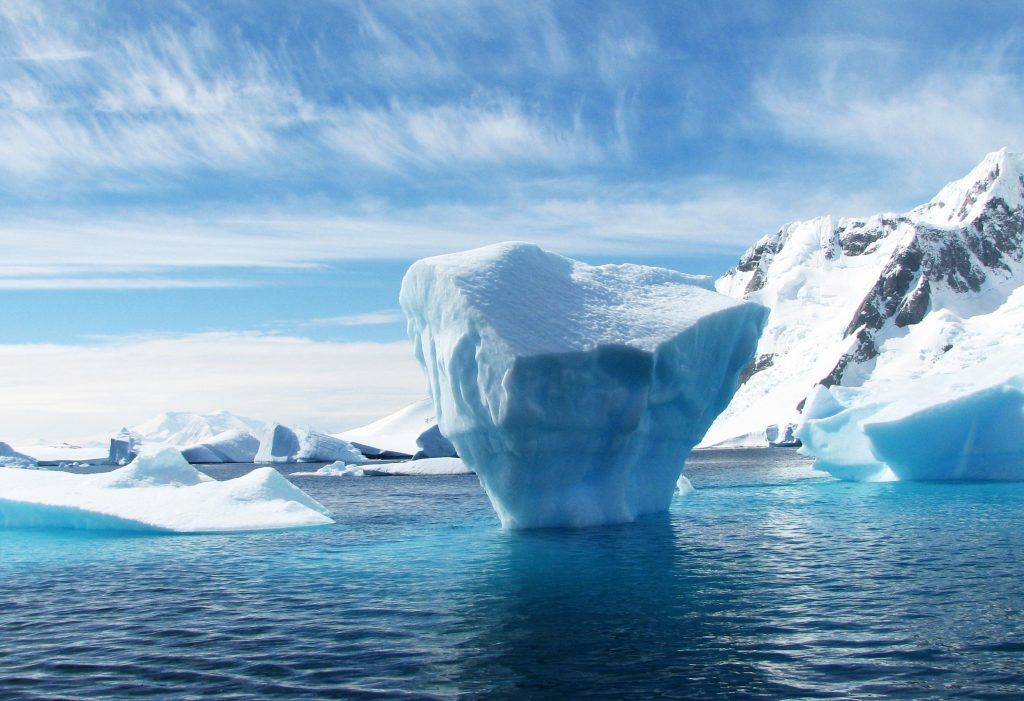How fast is the Arctic ice retreating? Just listen to it melt.
By Dan Drollette Jr | June 8, 2018
 Iceberg in Anarctica. Image courtesy of Pixabay from Pexels.
Iceberg in Anarctica. Image courtesy of Pixabay from Pexels.
What is the loudest thing in the sea?
The sound of a melting glacier, says oceanographer Oskar Glowacki of the Scripps Institution of Oceanography at the University of California at San Diego. When a glacier meets the sea, it sounds like a billion bubbles bursting all at once, creating a white noise that is very different from the sound of an individual melting iceberg—whose bubbles typically number only in the thousands, allowing people to hear more distinct, individualized popping sounds.
It may not seem like much at first on paper, but when the raw data from months of field recordings in a fjord in Norway is compiled into statistics and run through an algorithm, that is enough for researchers to tell the difference between a melting glacier and a melting iceberg, and even track an individual iceberg as it travels. And the technique can be used to estimate the speed at which glaciers and icebergs are melting underwater, right at that critical point where the ice meets the sea. Scientists can also use this budding field of “cryoacoustics” to determine, by sound alone, the volume of a chunk of ice as it calves from a glacier and crashes into the ocean, say Glowacki and his colleagues Grant Deane and Mateusz Moskalik.
And having a better idea of all this information could have many different possible ramifications. Not only will the sea level rise due to all that melting ice, but the fresh cold water released by the ice will alter the environment, impose different conditions for sea mammals to survive, affect the ocean’s salinity, and change the circulation patterns of ocean currents such as the Gulf Stream, with potentially huge impacts on human civilization.
The Bulletin’s Dan Drollette Jr. interviewed Glowacki, to find out more about the process of using sound to calculate the rate of melting glaciers, and what it could mean.
Just in the past 24 hours, a study published in the peer-reviewed journal Nature (June 13, 2018) revealed that the Antarctic is melting three times as fast as a decade ago.
(Editor’s note: This interview has been condensed and edited for clarity.)
Dan Drollette: Can you explain the overall idea behind this in a nutshell?
Glowacki: Well, as you probably know, satellites from space can be used to track the melting of glaciers or icebergs. But what is much harder to get data from is that spot where glaciers meet ocean water—and that ice-ocean boundary is where a big part of the melting occurs.
And because we are experiencing a climate shift, there’s a lot more melting going on; the oceans are becoming warmer and warmer.
So it’s important to understand what’s happening right at that interface. You really want to get a good picture of it, not just observe from space that the icebergs and glaciers are shrinking. We need to understand the relationship between the various factors, and the results.
From space, all you can observe is just that 100 cubic meters of ice disappeared, but the question is what are the processes involved, and what one can predict from that.
Dan Drollette: If I understand that Geophysical Research Letters paper you and your colleagues wrote, one of the things you found was that glaciers—the big bodies of ice that are on land—are more compact than icebergs—the chunks that have separated, or “calved,” from the glacier and are floating on water. Consequently, glaciers melt at a different rate than icebergs
Glowacki: Yes, these glaciers that are flowing towards the ocean are producing icebergs, and actually we found out that these glaciers are disappearing very rapidly because they are under contact between the ocean and the ice. And they’re very sensitive to climate shifts.
Dan Drollette: And they emit different sounds? The sound of a melting glacier is different from the sound of a melting iceberg?
Glowacki: That’s right. The reason they make sounds at all is basically because glaciers contain bubbles, which make sounds. We mentioned that a glacier is a big body of ice, and the number of bubbles in one is just enormous—there are billions of bubbles inside.
In contrast, when you have an iceberg, that’s a much smaller piece of ice, so you have only thousands of bubbles or so. That’s a big difference, which means that for a melting glacier, you just hear a constant cacophony of sound. Just listen. There are so many bubbles released to the water at the same time that you just cannot distinguish between individual pulsations.
But when there is an iceberg, you can actually hear the individual popping sound, of individual bubbles being released into the water. For example, listen to this iceberg recording.
Dan Drollette: So, when you have billions of bubbles going, it makes a different sound than when you have thousands of them popping, bursting?
Glowacki: Yeah, basically because there are so many bubbles bursting at the same moment, it’s like a constant, white noise.
And it’s very different for icebergs; you could actually hear that in the second clip, there was like a “pop, pop, pop” sound.
What’s more, by using statistical methods, we can then distinguish what part of a given audio recording is coming from a glacier and what part is coming from an iceberg.
That’s important, because if you are listening to the raw recording made under the water, you are basically listening to a whole bunch of sources at once—the glacier melting, the icebergs melting, the sea mammals, the breaking waves—and all that stuff is making noise. But when the iceberg is getting closer, it dominates the noise.
Dan Drollette: And so, using statistics, you can tell an iceberg from other things, such as a glacier. But do all icebergs sound the same? I mean, I understand that an iceberg sounds different from a glacier, but does that mean that all icebergs give off the same sound? Does an individual floating iceberg have a distinctive signature to it?
Glowacki: Not quite, but we can identify and track an individual floating iceberg.
Dan Drollette: How…
Glowacki: We anchor, for example, three hydrophones—underwater microphones—in three separate spots, and then measure the distance between the arrivals of the individual impulses, allowing these three hydrophones to estimate the direction of the source. Using that, we can basically distinguish between individual icebergs and glaciers, and basically the noise statistics tell us whether the iceberg is nearby or from a more distant source. Because, you know, when the iceberg is getting closer and closer, it’s much more simple to hear these individual explosions.
That’s why it’s so simple to hear these individual explosive noises.
Dan Drollette: And where have you tried this process? Should it work anywhere, such as the Antarctic or northern Canada?
Glowacki: We have tried it in the fjords of Svalbard, Norway, which we are treating as a sort of natural laboratory. We work from the Polish Polar Station in the southern part of Svalbard, about a ten-minute boat ride from the station to the glacier. And there are a lot of contributing factors that we try to take measurements of as well, such as water temperature, water salinity, and weather conditions. So that’s why it’s like a laboratory, because we have something like controlled conditions, that we can compare to.
We are doing our research in Svalbard, but there are people that are doing similar things in Alaska or Antarctica, and we are actually cooperating with them.
Dan Drollette: This might be a little bit of an aside, but I worked for a few years in Switzerland, where I remember going just across the border to Mont Blanc one weekend, where I saw and touched my first glacier. And I was amazed at, first of all, how dirty they are—they’ve got lots of rocks and debris.
Glowacki: Oh, yes.
Dan Drollette: And also at how loud it was. The glacier had kind of a little ice cave at the very base, and I was amazed at how loud the constant “drip, drip, drip” was on a summer’s day. Which brings me to my next question: Is it true that melting glaciers are one of the loudest places in the ocean?
Glowacki: Well, actually, they are the loudest place. My colleague here at Scripps is from California, and he’s one of the biggest experts in ocean acoustics. But when I went with him for the first time to the Arctic, he was amazed at the volume. He was listening to the noise and was like: “What? That’s not possible. What’s going on?” It was like that.
Dan Drollette: It was that loud?
Glowacki: It was that loud. He was so sure that there was something wrong with the microphones.
Dan Drollette: That’s amazing. How did you guys come up with the idea of putting a hydrophone in the water and recording these sounds?
Glowacki: Well, it wouldn’t be fair to say that it was our idea. It built on this data from around the 1950s.
Dan Drollette: How do you actually make the recordings? It must be more than just hanging a microphone off the side of a boat?
Glowacki: Well, we put on dry suits—designed for real cold water—and dive down to the sea bottom, where we place these hydrophones on the sea floor.
It’s pretty cold, but manage-able. Then after a year we have to go back, dive down and recover the hydrophone, which is more or less permanently in place, recording the whole time. But it’s not transmitting live to a satellite or whatever, instead it has memory cards inside, which we have to extract.
Dan Drollette: It can’t just bob just below the surface and transmit the information in real time?
Glowacki: No… and that’s an important part. Everyone asks: “Why not just transmit the data? It would be much simpler?” But because there are so many chunks of ice on the surface, it’s not so simple to have an antenna or something above the water.
There are icebergs calving, and chunks of ice, so the sea surface is almost like constantly covered by ice sometimes. So, while making acoustic recordings seems pretty simple at first, it’s complicated to find the right procedures. And to record the noise is just the beginning. We need to understand the noise, what we are listening to.
Dan Drollette: Have you found anything that hints at when a chunk of ice is about to calve, a warning that it’s about to happen?
Glowacki: So far, not yet. But we did find out that we can estimate the volume of ice that is falling from the glacier, based on the acoustics alone.
Just by listening to the sound that it produces as it crashes into the water, you can say, “Okay this was a thousand cubic meters of ice coming off a glacier,” or “This is a hundred cubic meters.” We found a direct relationship between the acoustics and the volume.
And the rate at which icebergs and glaciers melt has all sorts of ramifications. The resulting sea level rise will be huge, but that’s just one part of it. There is another point, which I think we are underestimating: When all that fresh, cold water is put into the oceans, it also changes the environment. All that cold freshwater affects the salinity, which means different conditions for sea mammals. And it also changes ocean circulation patterns, such as the Gulf Stream Current. This fresh water input can affect the global circulation of ocean waters, it can affect the local weather conditions for example in different places around the world.
Dan Drollette: So there’s all kinds of different implications that can come out of using acoustics to study glaciers and icebergs?
Glowacki: What we usually say is that this is a new field—call it “ambient noise cryology” or “cryoacoustics” or whatever—it’s studying the ice with noise. For some people it sounds ridiculous, you know: “Why are you going to listen to the ice?”
But I tell them that we are helping the science enter a different stage. Researchers have been using satellites for years, and have well-established methods. While we are in the position of establishing a new tool. They found out ways to use satellites to measure what is going on at the surface with glaciers and icebergs, while we are preparing the tools for going down under the water.
Together, we make the world safer.
The Bulletin elevates expert voices above the noise. But as an independent nonprofit organization, our operations depend on the support of readers like you. Help us continue to deliver quality journalism that holds leaders accountable. Your support of our work at any level is important. In return, we promise our coverage will be understandable, influential, vigilant, solution-oriented, and fair-minded. Together we can make a difference.
Topics: Climate Change, Multimedia















